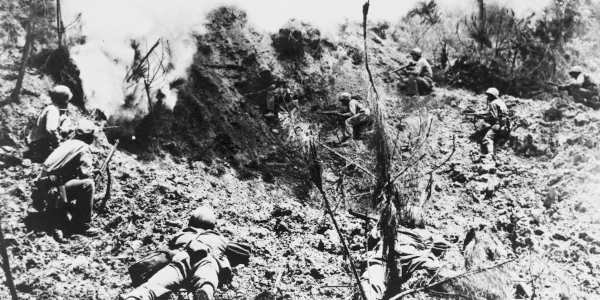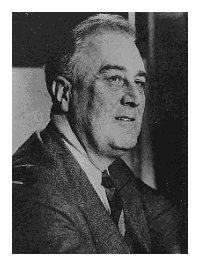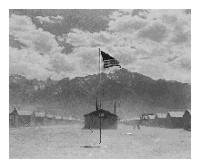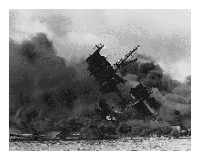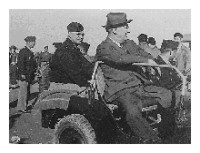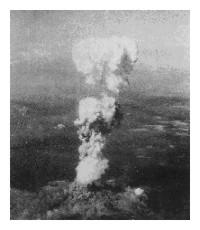Sponsor this page. Your banner or text ad can fill the space above.
Click here to Sponsor the page and how to reserve your ad.
-
Timeline
1945 Detail
February 19, 1945 - Thirty thousand United States Marines land on Iwo Jima. On April 1, American troops invade Okinawa, beginning the Battle of Okinawa, which would continue until June 21.
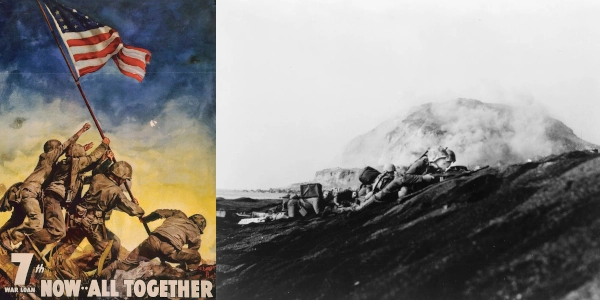
Warfare in the Pacific against Japan and its axis was quite different than that of the sea and land battles in Europe and Africa. After the bombing of Pearl Harbor, the United States sent the remainder of their Navy, Marines, Army, and Air Force to attack the Japanese whereever they could find them to make them pay for the destruction of the Navy Base in Hawaii. First, there was a four year battle to take back the islands which the Japanese had taken prior; the battles for Guam, Wake Island, the Coral Sea, Midway, and the Phillipines. By February of 1945, the United States and their Allies, had pushed against the Japanese and retaken much of that territory. It was now time to go after the Japanese on their own territory. The first of which would be Iwo Jima, an island no man other than the Japanese had ever set foot on.
There had been a strategic planning conference on September 30 to October 1, 1944 in San Francisco, with the generals and admirals from the Pacific Theater and the Joint Chiefs of Staff. General Douglas MacArthur forcefully pushed the plan, Operation Detachment; first Luzon, Phillipines, and then the islands of Japan, the Bonins-Volcano, where Iwo Jima was located. If they cut off this chain, and followed it by attacking the Ryukus, i.e. Okinawa, Japan's outer defense would be significantly weakened.
Significant fire power and divisions would be sent, including the U.S. Fifth Fleet (3rd, 4th, and 5th Marine Divisions plus the 147th Army Infantry Regiments and other support troops). There would be sixty thousand Allied soldiers against a defending force of twenty-one thousand Japanese. The Japanese had also changed strategy, no longer fighting them on the beaches, but luring them into traps further inland. Japanese airpower had already been neutralized; American airpower had their way, so the Japanese dug in deep at the orders of General Tadamichi Kuribayashi, who had taken command at Iwo Jima in June 1944 under orders of Premier Hideki Tojo. "Only you among all the generals are qualified and capable of holding this post. The entire army and the nation will depend of you for the defense of that key position," stated Tojo. Iwo Jima was four and one half miles long by two and one half miles wide. It was six hundred and sixty miles from Tokyo.
The bombing raids and recon done by the American forces prior to February 19 had underestimated the amount of fortifactions on the mountainous island. The fact that the intensified raids were only able to fly due to weather for three days, not ten, did not help. On the day of the assault, the 5th Marine Division (General Keller Rockey) landed on the beaches to the right; the Fourth Division (General Clifton Cates) on the left. The Japanese waited for the first wave to land and climb one hundred and fifty yards before beginning to fire. Coupled with unstable sand and volcanic ash, the American forces struggled to climb the beaches to jungle to Mount Suribachi under that fire. Despite the difficulty, within ninety minutes they had isolated Mount Suribachi. The Fourth Division struggled against heavy fire as they approached the airport. At the end of the first day, thirty thousand troops had landed, but the casualty count was high.
The Third Marine Division (General Graves Erskine) landed on February 20, 1945 and occupied a position between the two already engaged Divisions as the 28th Regiment of the Fifth Marine Division escalated the heights of Mount Suribachi against two thousand well entrenched Japanese soldiers. With three Divisions under one command, this became one of the largest Marine detachments committed to a single combat in World War II. It was under the command of Admiral Raymond A. Spruance and Vice Admiral Richmond Kelly Turner. Although there was progress by both the Third and Fifth Divisions on the second day, it had become a slog, with individual soldiers, with flamethrowers, attempting to roust the Japanese from the defensive holes. There were eleven miles of tunnels under the crust of the island.
On February 21 and through the end of the next month, slow headway was gained. Yes, the climb and capture of the crest of Mount Suribachi was accomplished on February 23, but around the rest of the island, each day saw arduous fighting. That capture and raising of the flag was significant and has maintained such through history. As James Forrestal, Secretary of the Navy, said witnessing the sight from the USS Eldorado, "... the raising of that flag on Suribachi means a Marine Corps for the next 500 years."
They captured Airfield #1, but their tank companies in the northern sector were thwarted often by well placed mines and attacks. Nine days into the fight, some soldiers had moved only four thousand yards and taken seven thousand casualties wounded and killed. On March 4, Airfield #2 was captured. The American Army claimed to occupy Iwo Jima by March 14, although fighting continued until March 26 when it was deemed officially secure.
And what was the outcome? Complete U.S. victory. They now had an airfield that could be used on further missions, however it proved less useful than they had hoped. Of the twenty-one thousand Japanese soldiers, four thousand went into hiding, two hundred and sixteen were capture, the others were either wounded or killed. From the United States standpoint, it had been a costly victory. 6,871 killed, 19,217 wounded.

Minute Walk in History - Battle of Iwo Jima
Watch our video about the capture of the first Japanese island in World War II, a costly but important fight for the Marines and the friends as they fought to place the American flag atop a large mountain. With historic video and snippets from American servicemen who were there, take a look at this historic battle and honor those who fought.
Battle of Okinawa
With the ending of the conflict of Iwo Jima on March 26, 1945, it was time for General Douglas MacArthur's plan to take its next step. They would attack the Ryukus island chain, i.e. Okinawa, in Operation Iceberg. The United States Tenth Army, under Lieutenant General Simon Bolivar Buckner, Jr., including one hundred and two thousand soldiers and Marines, attacked the island on April 1, 1945. The Tenth Army included the 7th, 27th, 77th and 96th infantry divisions, and the 1st, 2nd and 6th Marine divisions, plus a joint Army/Marine Corps tactical air force. They were assisted by soldiers from the United Kingdom, Australia, New Zealand, and Canada. In total, there were one thousand five hundred ships in the Fifth Fleet under the command of Admiral Raymond Spruance.
The Japanese force on the island numbered around one hundred thousand, the 32nd Imperial Army, under the command of Japanese Lt. Gen. Mitsuru Ushijima. His goal was to make the Allies pay for every inch, and perhaps, deter them from attacking mainland Japan. Again, the initial advance of the Allied forces faced no opposition on the beaches; the Japanese had followed similar tactics to that on Iwo Jima ... wait until the U.S. had penetrated to their well developed defenses. Admiral Spruance remarked of the lack of fighting on the beachs, "I may be crazy, but it looks like the Japanese have quit the war, at least in this sector." They had not.
It rained, monsoon strength. The terrain was rugged. Five days after landing, the Japanese sent three hundred and fifty-five Kamikaze pilots to attack Allied ships.
This would be no quick battle. There was success on the northern end of the island, the Motobu Peninsula, with opposition diminished by April 8. However, it would take eighty-two days before the Japanese entrenchments in the south could be overcome and gain victory. They had to control the Machinato Line, the initial line of Japanese defense, which took until April 20. Shuri Castle fell on May 29. An amphibious assault on the Naha Airfield started on June 4. Kamikaze attacks had continued throughout those months; a total of two thousand planes with Ohka flying bombs assaulted the fleet. Thirty-six ships were sunk and three hundred and sixty-eight damaged. But the Fleet survived, with heroics from the USS Hugh W. Hadley, a destroyer, knocking twenty-three Japanese planes from the sky in less than two hours, as well as many others.
The casualty count for both sides was horrendous. Forty-nine thousand American and Allied troops killed, wounded, and missing, with twelve thousand among those who gave the ultimate sacrifice. There was a high number of casualties on the Navy ships, nearly forty percent of the total. The losses included the operation commander, Lieutenant General Simon Bolivar Buckner, Jr., who died on June 18 during the last offensive. He was the highest ranking military official who died in the Pacific Theater. War correspondent, Ernie Pyle, known for his myriad stories throughout World War II, was killed off the coast on April 18.
Ninety thousand Japanese soldiers were killed; up to one hundred and fifty Japanese civilians also died, some being women and children who were used as human shields. The island had a population of five hundred thousand before the attack.
The plan was to use Okinawa as a base to attack the mainland of China. However, after the nuclear bombs dropped at the order of President Harry Truman, inaugurated after the death of President Franklin Delano Roosevelt on April 12, on Hiroshima on August 6 by the Little Boy bomb from the Enola Gay. When detonated, the temperature on the ground reached seven thousand degrees. A second bomb, the Fat Man, hit Nagasaki on August 9, 1945 from the B-29 Bockscar. Instantly tens of thousands were killed.
The Japanese Imperial Government surrendered unconditionally on August 15, 1945.
Minute Walk in History - Battle of Okinawa
The horror of war as the United States Army, Navy, Marines, and more attack the island of Okinawa, in what would be the last major battle in the Pacific Theater of World War II. With music beneath the honor of the soldiers and the horrific scenes of war in archival footage, witness bad, but necessary history when peace needed a chance.
Photo above: Montage (left) Raising flag atop Iwo Jima (photo by Joe Rosenthal) used as 7th war loan promotion, 1945, Cecil Beall, Department of Treasury. Courtey Library of Congress. (right) The Second Battalion, Twenty-Seventh Marines land on Iwo Jima, 1945, Bob Campbell, Defense Department. Courtesy Library of Congress. Below: Marines wait at entrance to cave in which Japanese soldiers are hiding outside Naha, 1945, Unknown Author. Courtesy Library of Congress. Source: "Battle of Iwo Jima," 2020, Carsten Fries, history.navy.mil; "Keystone Battle Brief, the Battle of Iwo Jima, February 19 to March 26, 1945," 2016, usmcu.edu; "The Battle of Iwo Jima," 1967, Robert Leckie; "Battle of Okinawa," National World War II Museum; "Remembering the Battle of Okinawa; Lessons Learned for Future Fights," 2025, David Vergun, U.S. Department of Defense; "Okinawa, the Final Battle," 2025, Margaret Dudley, National Museum of the Pacific War; "The Atomic Bombings of Hiroshima and Nagasaki," Manhattan Project National Historical Park; Wikipedia.
